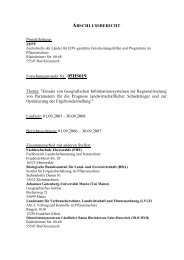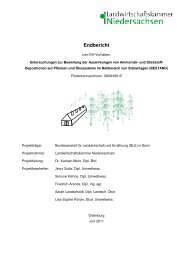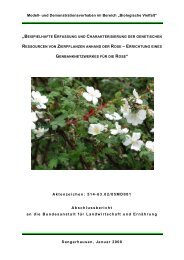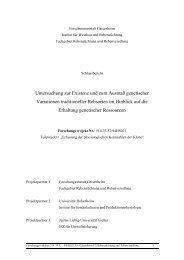Forschungs- und Entwicklungsvorhaben FKZ 01UM022/1 ... - BLE
Forschungs- und Entwicklungsvorhaben FKZ 01UM022/1 ... - BLE
Forschungs- und Entwicklungsvorhaben FKZ 01UM022/1 ... - BLE
Erfolgreiche ePaper selbst erstellen
Machen Sie aus Ihren PDF Publikationen ein blätterbares Flipbook mit unserer einzigartigen Google optimierten e-Paper Software.
FVH Az UM022/1 „Biol. Bekämpfung Apfelwickler“ Hopfenbauverein Immenstaad Abschlußbericht 53<br />
If the population is high for the following year, there can be easily further problems. The<br />
concept “keep down the populations” has also great advantages regarding the risk<br />
management.<br />
The treatments of the commercial orchards were done always mainly against the frist<br />
generation of Codling moth. During this period, the application of CpGV can be combined<br />
with the fungicide treatments which are often necessary. In late summer, when fungicide<br />
treatments are usually not that frequent, CpGV treatments were also rare due to the effect of<br />
the mating disruption.<br />
During the time of the investigation (4 years) the Codling moth population of the area<br />
covered by the project did not show any sign of a reduction of the susceptibility to CpGV.<br />
This reduction, however, could be shown in other populations originating from organic<br />
orchards in this and other regions where problems with codling moth arose in 2003.<br />
Nearly all the populations sampled in organic orchards with codling moth problems arising in<br />
2003, 2004 and 2005 proved to be 1,000-fold less susceptible to CpGV than other<br />
populations. Most organic orchards in Germany (about 500-600) do not show any codling<br />
moth problems until now. Still it is not known if resistant codling moth populations have<br />
always existed in nature and have been selected now or if there is another backgro<strong>und</strong> of the<br />
resistance building.<br />
Nevertheless, actually the strategy developed in this project must be discussed also <strong>und</strong>er<br />
the aspect of the risk of resistance building.<br />
Another problem was Grapholita lobarzewskii. It was present in all orchards at the end of the<br />
project, However, damage was caused only in few cases. The monitoring and prognosis with<br />
pheromone traps proved to be difficult due to behaviour of this species that occurs on small<br />
spots and does not disperse in the whole orchard. A solution for this problem could be the<br />
application of mating disruption for this species. Actually, this pheromone is not registered in<br />
Germany.<br />
In the recent situation, it seems best to introduce also one treatment with a synthetic<br />
pesticide to control Grapholita lobarzewskii in June into the basis strategy, and to establish a<br />
certain resistance management for CpGV.<br />
The reduction of Adoxophyes orana in the area covered must not be necessarily due to the<br />
strategy performed with area-wide granulovirus treatments. A similar reduction could be<br />
observed in the whole region. A very high parasitization of the larvae of the summer<br />
generation in the second year was obvious. Due to the “collapse” of the population this could<br />
not be observed further. The occurrence of Spilonota ocellana, Noctuid larvae and<br />
Operophtera brumata must be considered planning a strategy based on granulovirus<br />
treatment against Adoxophyes orana.<br />
7 Zitierte Literatur<br />
Andermatt, M. (1989): Die mikrobiologische Bekaempfung des Schalenwickler Adoxophyes orana F.v.R.<br />
mittels Granuloseviren. Diss. ETH Zuerich.<br />
Bathon, H., 1981: Zur Zucht des Apfelwicklers, Laspeyresia pomonella (L.) (Lep., Tortricidae), auf<br />
einem künstlichen Nährmedium. Mitt. dtsch. Ges. allg. angew. Ent. 2, 136-140.<br />
Charmillot, J.P. & Pasquer, P.J. (1998): Le virus de la granulose du carpocapse Cydia pomonella: 3.<br />
Essa pratique de longe durée. Revue Suisse Vitic. Arboric. Hortic. 30 (3): 185-187.
















